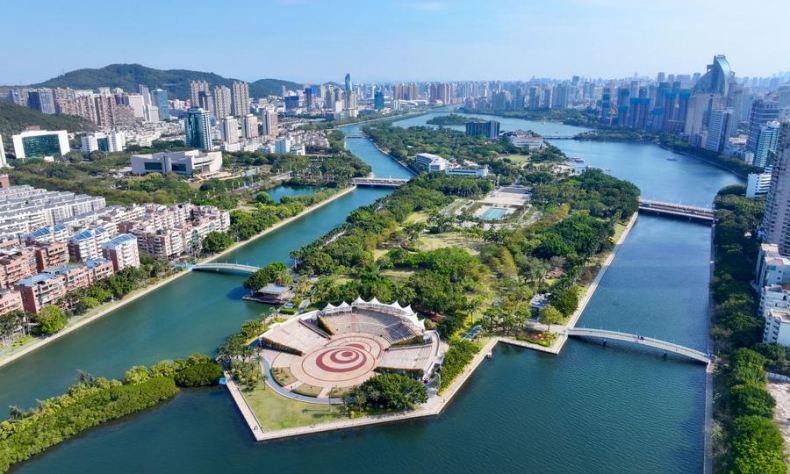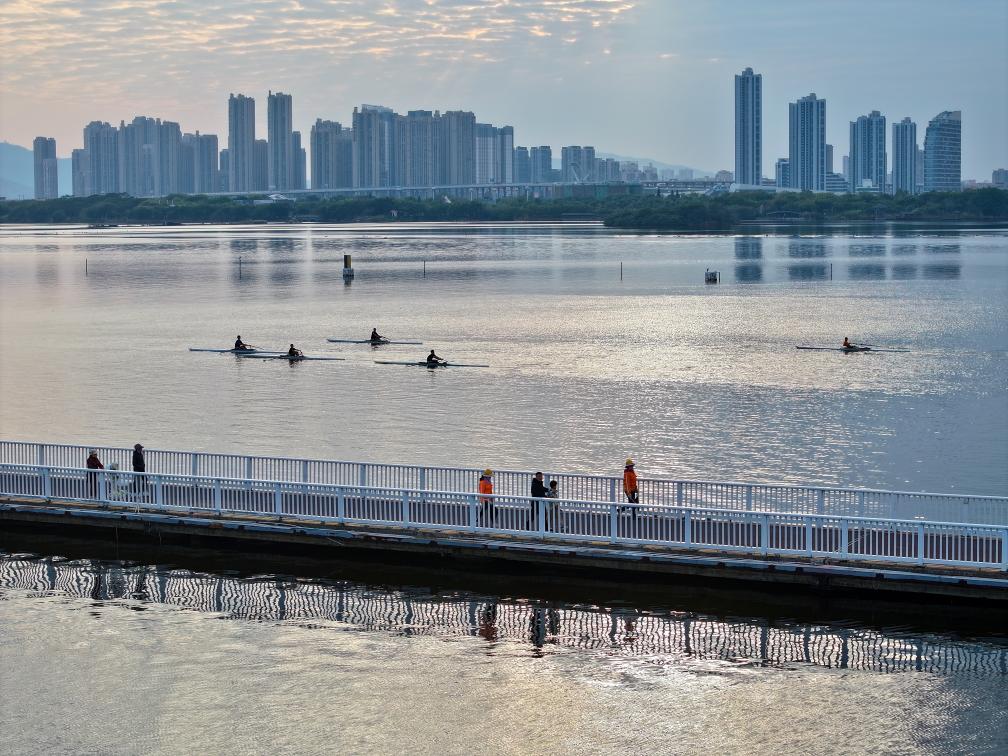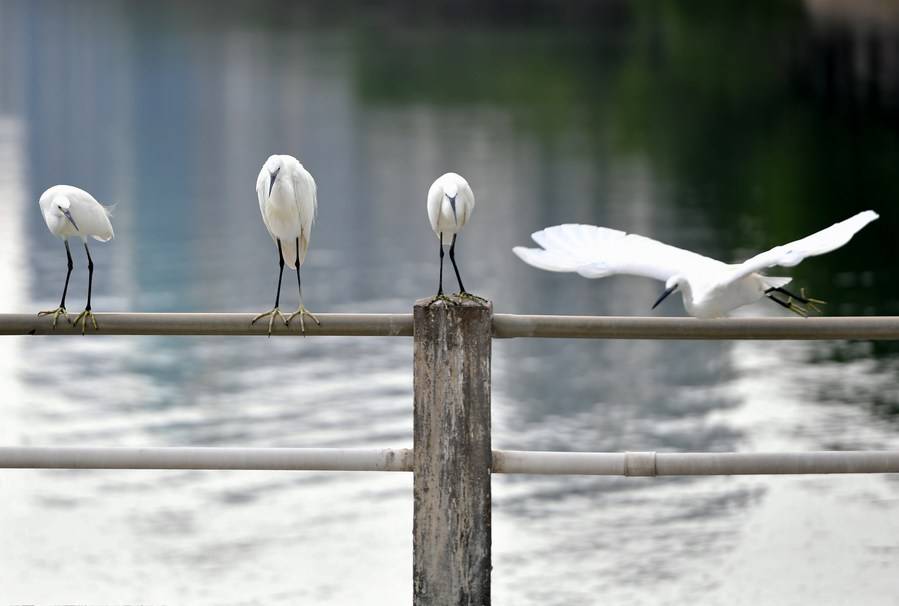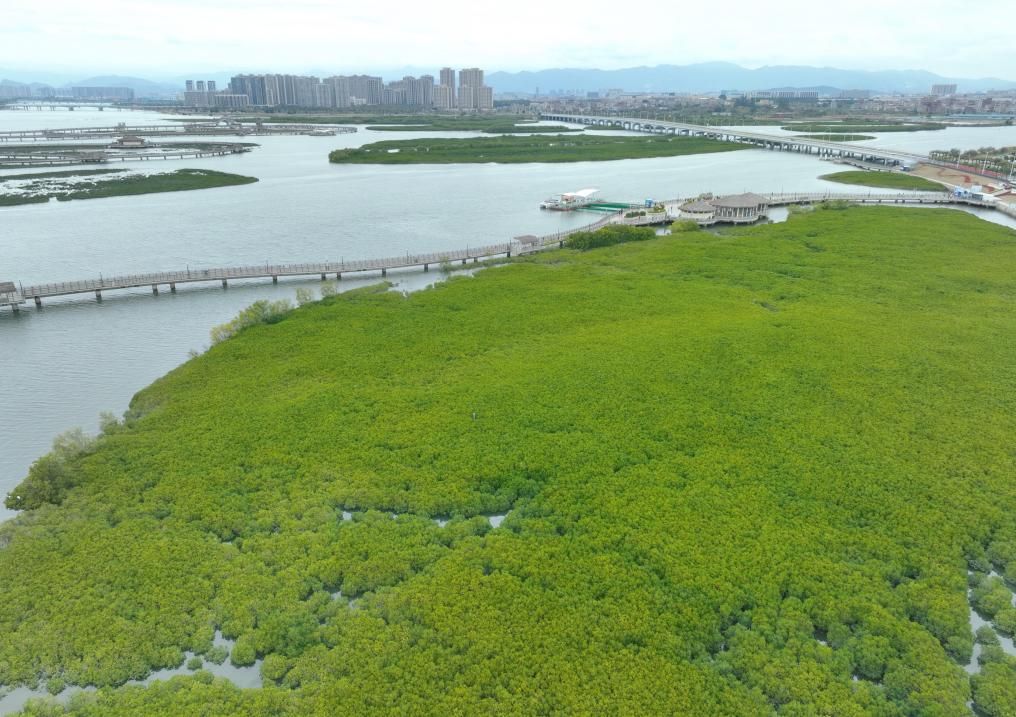Beauty Restored

Xiamen presents a successful case of sustainable development of a bay city.
Riding along Xiamen’s Xinglin Bay Marine Bicycle Lane feels like gliding between the sea and sky. This 2.6-km-long pathway, built above the sea, links two sides of the bay.
Every weekend, the lane, situated along the coastline in Xiamen’s Jimei District, transforms into a hotspot for visitors. Among them is Theogene Habumugisha, a Rwandan living in Xiamen.
“This is my favourite scenic spot in Xiamen. My friends and I often come here to ride. The scenery is delightful, the air is fresh, and it’s very comfortable,” he told ChinAfrica.
However, Xinglin Bay wasn’t always this pleasant – it was once polluted and dirty. Xiamen, located in southeast China’s Fujian Province, is a typical bay city rich in marine resources. But years of development along its small coastal area severely damaged its marine ecosystem.
About 30 years ago, the city embarked on a mission to restore its ecological environment. Beginning with Yundang Lake, Xiamen launched comprehensive preservation and restoration efforts across its coastlines, river basins, and surrounding regions. The city adopted an integrated approach to land and sea development, resulting in significant improvements to its ecology.
Today, Xiamen boasts a vibrant bay environment and thriving ecosystems, serving as a model for marine ecological protection both domestically and internationally. The city has garnered over 20 prestigious accolades, including the UN-Habitat Scroll of Honour Award, the International Awards for Liveable Communities, and the Achievement Award for Best Practice in Marine Ecological Conservation and Restoration by the East Asian Seas Congress.
A vital recovery
Yundang Lake, the only artificial lake in Xiamen, spans 1.6 square km and is located at the heart of the city. Connected to the sea, the lake is often described as an “urban living room,” with its clear waters, leafy banks, and abundant birds and flowers.
“The changes in this lake over the past 30 years have been monumental,” Zhong Pengze, a staff member at the Technical Quality Section of the Yundang Lake Protection Centre, told ChinAfrica.

In the 1970s, raw sewage from hundreds of thousands of nearby homes and industrial waste from over 300 factories flowed directly into the lake, turning it into an unpleasant cesspool.
Beginning in the 1980s, local authorities initiated efforts to tackle the pollution. Over the course of a five-phase comprehensive plan spanning 30 years, the lake underwent a remarkable transformation. Its restoration became a cornerstone of Xiamen’s ecological progress. Encouraged by the success of the Yundang Lake restoration effort, Xiamen gradually rolled out restoration and preservation programmes for other bay areas.
“Different bay conditions require different responses,” Yang Shengchang, an associate professor of environmental studies at Xiamen University, told ChinAfrica. For the makeover of its bays, the local government implemented a “one bay, one policy” strategy, customised to each bay’s unique features.
Tong’an Bay, once a tidal flat, has been transformed into a romantic coastal tourism site. Maluan Bay, previously a stagnant pool, is now an urban landscape highlight. Wuyuan Bay, formerly known as a “bad tidal beach,” has now become a popular tourist attraction. These efforts have reshaped Xiamen’s coastline, creating a harmonious blend of natural beauty and ecological sustainability.
A heaven for birds
Birds are important indicators of ecological health. Burkhard Risse, a bird-watching enthusiast from Germany who has lived in China for years, has identified numerous bird species in Xiamen that he had never seen before.
“There’s a great diversity of bird species in Xiamen. Birdwatching sites such as Bailuzhou Park and Xiatanwei Mangrove Coastal Wetland Ecological Park are well-situated and teeming with life. During my first trip, I photographed egrets, herons, night herons, and black-collared starlings,” he told ChinAfrica.
Lin Tao, deputy director of the Ecological Environment Planning and Management Research Centre and a researcher at the Chinese Academy of Sciences, frequently visits Yundang Lake for bird photography. He observed that the variety and number of bird species around the lake have steadily increased, a testament to the area’s improving ecological conditions.
The harmonious coexistence between humans and nature, exemplified by the thriving bird populations, has become a trademark feature of Xiamen’s ecology.

Restoration of mangroves
How can we protect marine ecosystems, stabilise ecological barriers, and inject vitality into coastal environments? Xiamen provides a compelling answer through its efforts to restore and conserve mangroves along its coastline.
Mangroves refer to woody plant communities thriving in the intertidal zones of tropical and subtropical coasts. Named for their red bark, which is rich in tannic acid, mangroves have great ecological value. They protect coastlines from wind and waves, purify seawater, and provide habitats for fish, shrimp, and birds. Their importance for marine biodiversity has earned them the nicknames of “coastal guardians” and “oceanic green lungs.”
At Xiatanwei Mangrove Park in Xiang’an District, a vibrant mangrove forest now stands as a living example of the ecological restoration, contrasting beautifully with the bay’s scenic waters. This park is the largest artificially reconstructed mangrove ecological wetland in Fujian Province, drawing a steady stream of visitors each day.
However, just over a decade ago, Xiatanwei was a dumping ground littered with waste from reclamation and unregulated aquaculture activities. These harmful practices caused severe seawater pollution and significant damage to the mangrove forests.
To fix the problem, Xiamen implemented a series of restoration projects beginning in 2005. It engaged a research team led by Lin Peng, an academician of the Chinese Academy of Engineering and a professor at Xiamen University, also known as the “father of Chinese mangroves.” The team planted approximately 6 hectares of experimental mangrove forests.
After more than a decade of science-based cultivation, the mangrove forests in Xiatanwei have been revived, bucking the global trend of accelerating mangrove loss. Today, the mangrove forest spans 85 hectares, forming a “green buffer zone” that serves as a natural ecological barrier against disasters such as typhoons and storms.
Mangroves also play a vital role in carbon sequestration. According to environmental experts, one hectare of mangroves can absorb 4.3 tonnes of carbon dioxide annually. This capability proved valuable during the ninth BRICS Summit in Xiamen in September 2017, which became the first zero-carbon-emission BRICS event. To offset the summit’s greenhouse gas emissions, 38.7 hectares of mangroves in Xiatanwei were designated as a carbon sink area.
The benefits of these mangroves extend beyond ecology, said Lu Changyi, a professor at Xiamen University and Lin Peng’s first graduate student. They generate significant social and economic value. Xiatanwei Mangrove Park, for instance, attracts up to 46,000 visitors daily during peak times, which boosts tourism and investment in improving the surrounding living environment.
A study by the College of Environment and Ecology at Xiamen University found that, as of the end of 2023, Xiamen’s mangrove coverage has reached 180 hectares.

A great example
Over the past 30 years, Xiamen has built partnerships globally and shared insights and experiences in global marine governance. It has held training in Costa Rica on mariculture technology and marine spatial planning, collaborated with Thailand on beach restoration in Pattaya, and established a joint marine ecology station in North Sulawesi of Indonesia.
“Xiamen has become a model for high-level ecological restoration in global bay cities, and the ‘Xiamen practice’ is worth learning from,” Erik Solheim, former UN Environment Programme executive director and under secretary general of the UN, said.
To further enhance global cooperation, Xiamen held an international marine city forum in 2005, which was upgraded in 2007 into World Ocean Week. Held annually for 18 years, the event has become a major venue to promote global marine ecology cooperation.
Xiamen has also established many platforms for international marine exchanges, including the APEC Marine Sustainable Development Centre, the BRICS Innovation Base Talent Training Platform, and the Ministry of Commerce’s Foreign Aid Marine Field Foreign Exchange Base, actively sharing Xiamen’s experience with the world.
In 2006, the PEMSEA Network of Local Governments for Sustainable Coastal Development, a self-sustaining network of local governments implementing integrated coastal management (ICM) programmes, established its permanent secretariat in Xiamen. This initiative fosters cooperation among its 53 member cities from 10 countries, focusing on marine resource development and ecological restoration.
Xiamen University offers a master’s degree programme in maritime affairs, with one-third of the students hailing from Indonesia, Bangladesh, Pakistan, and other Belt and Road Initiative participating countries.
“Marine ecological governance is a global challenge. In the past, Xiamen benefitted from international maritime exchanges and cooperation, and now it would like to share its expertise with others,” Zhou Lumin, a member of Xiamen’s Marine Experts Group and former director of the Xiamen ICM Project Management Office, told ChinAfrica.
The balance between economic growth and environmental protection has long been debated. “Xiamen’s experience in ecological protection shows us that the two are not mutually exclusive; they can be mutually reinforcing,” stated Tungamirai Eric Mupona, a young Zimbabwean visitor in Xiamen.
 Facebook
Facebook
 Twitter
Twitter
 Linkedin
Linkedin
 Google +
Google +










